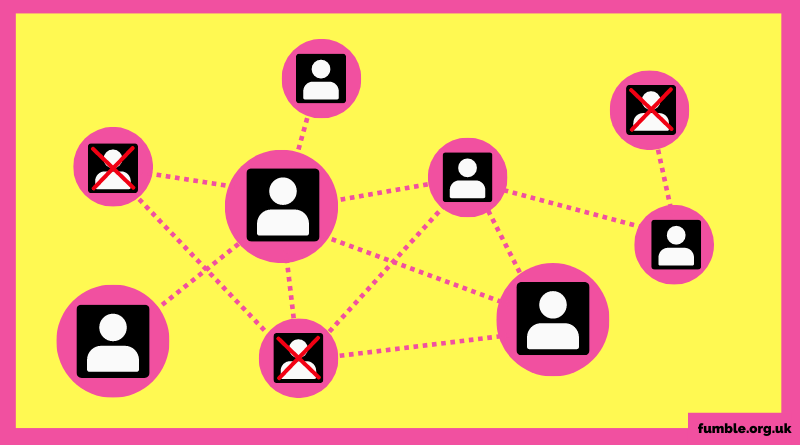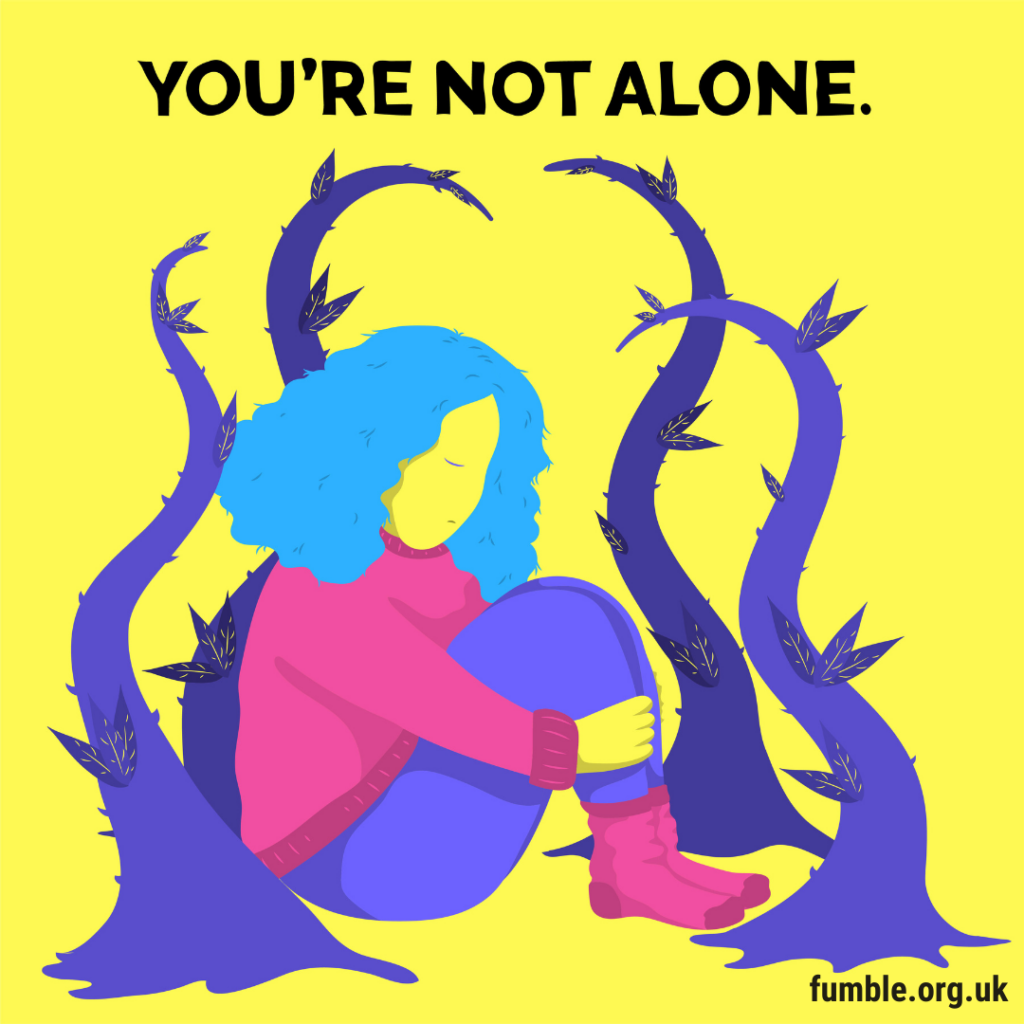A Fumble guide to sexting and sending nudes, and where to get support if you need it
Sex and sending nudes are ways to describe online flirting. You may have heard of ‘sexting’, which usually means sending sexual messages. This could be text or photos (often called “nude”). Some people just use the phrase “sending nudes”, which usually refers specifically to sending nude/semi-nude photos or videos of yourself to someone else.
Flirting online can be a lot of fun! Sometimes people find it easier to talk about what they like sexually or share personal feelings via text rather than face to face. Talking about sex and fantasies can sometimes feel uncomfortable. Doing it over text can make people feel more comfortable. Sometimes people also want to take pictures/videos of themselves. It can feel powerful and be part of one’s self-love. And sometimes people find it exciting and intimate to share their photos/videos with other people.
Sharing these photos/videos is something that gets a little tricky, so we’re going to look at the different points to think about: consent, the law, and where to get help if someone needs it.
There is a lot of support available if something has gone wrong and you need support. If this is the case, you can go straight to our section: I’m getting help.
Consent
As with anything sexual, consent is very important. Some people will find it fun to send and receive nude/sexual messages. Some won’t. No one should ever be forced to do something sexual they don’t want to do. This also applies to sending nude or sexual messages.
It doesn’t matter if you’re in a relationship with this person, if you’ve had sex with them, or how many times you’ve had sex with them, you don’t need to send anything. It can feel very difficult to say no to someone, especially if you have feelings for them. ThinkUKnow has some tips on ways to say no if you find it difficult.
We have to keep this in mind – how hard it can be to say no or not feel the pressure – if we’re asking someone to send nude or sexual messages. Even if you think you’re not pushing someone, that person may feel they have to send it to keep you happy or interested. This may seem complicated – how can we ask for consent when people may not give the answer they really feel! Just make sure you reassure this person that you don’t expect anything and their response won’t change how you feel about them. Even if they have sent something before. Reassurances help this situation a lot.
Checking in before sending nude or sexual messages is also important. You may think it’s fun or not a big deal, but we don’t know how someone else feels about receiving nude or sexual messages unless we ask them. They might find it annoying or offensive, so make sure you check in first.
This can seem a little more difficult when it comes to long-term, more established/committed relationships, where it may not feel necessary to check every time. Maybe you already have a habit of sending nude/sexual messages, or maybe it’s a “surprise”. This just takes some thinking about the relationship you have with that person and, more importantly, reflecting and listening to the other person if you cross the line.
What about the law?
There are a few different age restrictions in terms of law and gender.
It is illegal to have (physical copy or on your phone/laptop) or send nude/semi-nude photos or videos of anyone under 18. This is because anyone under 18 is a child in the eyes of the law. It means that the images are sexual photos or videos of a child.
It is very important to know that this law exists to protect children and young people, not to punish or criminalize them.
For a little context: this particular piece of the law was passed in 2003, before camera phones were so common and readily available. Now the majority of people own smartphones, but they didn’t back then. In 2003, it wasn’t common or easy for young people to take pictures of themselves, never mind send them to someone else so easily. Technology has changed things very quickly!

To help inform this law, Outcome 21 was created. This is a handy piece of legislation that allows the police to record a ‘crime’ as having occurred, without having to take any official action.
For example, if someone under 18 sent a nude of themselves to someone and someone shared the nude with others without consent, the situation could be recorded in order to investigate the non-consensual sharing, without punishing the young person for the act. sending the naked in the first place. This example is a type of image-based sexual abuse.
What to do if your nakedness is shared around you?
This is a form Image-based sexual abuse (aka “revenge porn”). Other examples are:
- Someone taking a nude/semi-nude photo or video of someone else without their knowledge or consent
- Uploading a nude/semi-nude photo or video online without that person’s consent
- Share a nude/semi-nude photo or video with other people, via messages or in person
If someone experiences sexual abuse based on an image, it is never their fault. This is a horrific form of abuse and anyone experiencing it deserves kindness, empathy and support to overcome it and build their self-esteem.
If this happens to you, get help (see our list below). You don’t have to deal with it alone.
I’m getting help

Sometimes knowing that it’s illegal to send nudes to under-18s means young people don’t seek help when something goes wrong. But the law exists to protect children and young people, not to punish them. It is very important that if something goes wrong and your nude is shared without your consent, you know that help and support is available for you. You are not the one who is wrong. the person who shared/uploaded your image without your consent is.
There is also help and support for anyone receiving unwanted nude or sexual messages. No one should receive inappropriate photos/videos or messages they don’t want. This goes back to its meaning consent. Being spammed nude can make us feel angry, upset, offended, shocked, confused, and many other negative emotions, and it’s important to have space to express that. Make sure you talk to people. Again, you don’t have to deal with this alone. Unsolicited nudity or sexual messages can also be reported on the platform itself and/or through the organizations below.
Sometimes it can be difficult to talk to adults about it, such as parents/carers and teachers. If this is the case, there is great support online. These organizations support young people in many different difficult situations, such as image-based sexual abuse, and will be able to help. They can also help you get the image under control without necessarily investigating those responsible, in case someone is worried about getting someone else in trouble.
- Children’s line – a helpline and one-to-one advisor chats to support you
- The Internet Watch Foundation – anonymously report any images on the internet
- CEOP – make a report if you have experienced any online sexual abuse (including image abuse)
There’s also help and support if you’re 18 or over. Regardless of age, if someone shared a nude/semi-nude photo of you without your consent, they are breaking the law.
If you are 18+, you can get help from:
Childline: “No one has the right to share a nude of you.”
What to do if they share someone else’s nude?
Talk to a trusted adult or get help from any of the organizations listed above. The photo/video doesn’t have to be yours to get help.
Never show the photo/video to anyone else. By sharing it, you become part of the abuse.
Remember that it is not the fault of the person in the picture. Just as we deserve kindness, empathy and support if we are experiencing this form of abuse, so does this person. It is very likely that they did not take this photo/video wanting or expecting many people to see it. Don’t judge them. Don’t blame them. Resist the victim blaming culture that often surrounds sexual abuse and give them the kindness they will need. Sharing images is often what provokes a reaction or causes drama for that person. Take control and refuse to participate!
Other support
read more
Last reviewed on August 31, 2022
Image credit: Pradamas Gifarry via Unsplash


